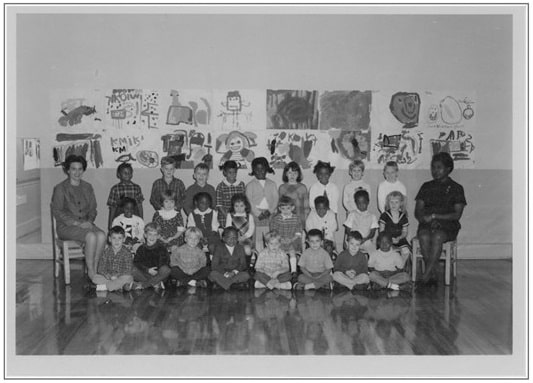NEWS
Davidson’s First Kindergarten

Paula Kelton and Dovie Howard with their kindergarten class. (phoro courtesy of the Davidson College Archives)
 Publicly-funded kindergartens were common in the Northeast and Midwest by 1960. I attended one such kindergarten in Pennsylvania in 1951, under my kind but formidable teacher, Miss Fawcett. North Carolina and the other Southern states were slower to establish kindergartens in public schools. Although private nursery schools and kindergartens existed as early as the 1830s, the first bill to establish public kindergartens in North Carolina was presented to the legislature in 1963. It, along with similar bills presented in 1965 and 1967, failed to pass.
Publicly-funded kindergartens were common in the Northeast and Midwest by 1960. I attended one such kindergarten in Pennsylvania in 1951, under my kind but formidable teacher, Miss Fawcett. North Carolina and the other Southern states were slower to establish kindergartens in public schools. Although private nursery schools and kindergartens existed as early as the 1830s, the first bill to establish public kindergartens in North Carolina was presented to the legislature in 1963. It, along with similar bills presented in 1965 and 1967, failed to pass.
In 1967 Governor Dan Moore asked the General Assembly to create a commission to study North Carolina’s public schools. The committee’s findings, presented in 1969, concluded that public kindergartens should be a top priority. In July of that year, the General Assembly enacted a bill setting out the legal means by which such kindergartens could be established. Consequently, the State Superintendent of Public Instruction invited school districts to submit proposals for demonstration projects, and a number were opened. Universal kindergarten for public school students did not begin until 1978.
Another development, however, allowed kindergarteners in the Davidson area to attend school earlier. In 1965 Title I programs provided by the federal government became available, and the following year they were introduced in North Carolina. Title I was under the auspices of the newly enacted Elementary and Secondary Education Act (ESEA). These federal funds provided not only kindergarten programs but workshops and summer classes for their staffs.
In 1966 the Charlotte-Mecklenburg schools were integrated and all-black schools, including the Ada Jenkins School in Davidson, were closed. At the same time, however, the district was instituting a kindergarten program for five-year-olds, and Davidson was one of the towns chosen to participate. This free kindergarten, called the Child Development Center, opened at the Ada Jenkins school in February of 1967.
Federal funds were generous enough to provide good equipment, an excellent staff, and to pay for such activities as field trips. The staff included a secretary, a nurse, a social worker, a dentist, and art and music teachers. Teachers visited each child’s home before school started, and the nurse also made home visits.
Adeline Ostwalt was in charge of the kindergarten, which was designed to prepare 150 five-year-olds from Davidson, Cornelius, Long Creek and Huntersville for first grade. According to Ostwalt, her involvement in the project “came like a thunderbolt . . . That was the middle of January, and I didn’t have but a month to get everything ready. It was chaotic, but I had the help and cooperation of everyone in the school administration all down the line.” There were eight classes of twenty children, each supervised by a teacher and an aide.
According to a January article in the Mecklenburg Gazette, the school was intended to include both black and white students from diverse backgrounds. The school day ran from 8:30 a.m. until 3:00 p.m., and included a morning snack, a hot lunch, and a nap. According to James T. Burch, a representative from ESEA , the initial request for the school came from Davidson’s Committee on Community Relations, a bi-racial committee established in 1963. According to Burch, “one of the principal reasons why a kindergarten program is being initiated in Davidson is due to the quality of community interest and support which has been shown in this area. The availability of a sound building in the general area was also a contributing factor.”
One drawback to the program was that the children were bused for long distances. Even with five buses, the round trip was 48-60 miles, making the school day very long for such young children.
According to The Davidsonian, the kindergarten curriculum, administered by nine teachers, nine assistant teachers, and three teachers’ aides, included “aspects of language arts, social studies, physical education, manipulative arts, music, number concepts and natural sciences.” If the teacher in a class was white, her assistant was African American, and vice versa. The program utilized twelve rooms in the school.
The indoor gym was used for “the type of muscle building exercises which five-year-olds need.” One of the most popular areas of the gym was the tricycle area, complete with miniature road signs. The nurse and the cafeteria staff cooperated to make sure that “each student is learning good health and nutritional habits.” Since the kindergarten opened in the winter, the program would run through the summer.
In July, the Mecklenburg Gazette reported that over 100 children were “having the time of their lives in a bright, busy atmosphere.” Ostwalt said some children were at a severe disadvantage, abused at home or unable to communicate. These problems were met by “individual attention, something the public schools have always lacked because of the pupil load.” Having a full-time social worker on the staff provided “a link with the home that most schools cannot match.” In addition, the school provided physical exams and visits to the dentist.
As for integration, Ostwalt declared: “as far as we’re concerned, these are just children. They are all treated alike, each one on his own merits. We have Negro teachers and white teachers and, in each classroom, the teacher and her assistant will be of the opposite race. Really…the kids couldn’t care less.” Some white parents had doubts about the situation, wanting their children in kindergarten but not at an integrated school. Ostwalt suggested they come visit and see how the school operated, and reported that “Almost invariably, they send their child in.”
The Child Development Center only operated at Ada Jenkins until 1972. When it closed, some local children were able to attend kindergarten at the Davidson College Presbyterian Church. Public kindergarten was not introduced at Davidson Elementary School until 1978.
Nancy Griffith
Nancy Griffith lived in Davidson from 1979 until 1989. She is the author of numerous books and articles on Arkansas and South Carolina history. She is the author of "Ada Jenkins: The Heart of the Matter," a history of the Ada Jenkins school and center.


